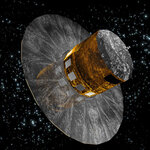What is Gaia?
Gaia is a major space astronomy mission by the European Space Agency ESA launched on December 19, 2013, performing astrometry, photometry and spectroscopy of about one percent of all stars of our Galaxy at very high precision. Gaia builds upon the European heritage of precision stellar mapping that was exemplified by ESA's HIPPARCOS mission in the late 1980s. Whereas that mission catalogued one hundred thousand stars to high precision, and over one million to lesser accuracy, Gaia maps more than one billion stars to unprecedented levels of precision.
Gaia's name was derived as an acronym for Global Astrometric Interferometer for Astrophysics. This reflected the optical technique of interferometry that was originally planned for use on this telescope. However, the working method has now changed. Although the acronym is no longer applicable, the name Gaia remains to provide continuity with the project.
Objectives
Gaia's main scientific objective is to use its census of stars to clarify the origin and subsequent history of our galaxy, the Milky Way. As well as this, Gaia is expected to become astronomy's greatest discovery machine. Estimates suggest that Gaia will discover the following quantities of celestial objects:
- up to a million asteroids and comets within our own Solar System;
- thirty thousand planets beyond our Solar System;
- fifty thousand failed stars, called brown dwarfs;
- hundreds of thousands of dead stellar remnants, called white dwarfs;
- twenty thousand exploding stars, called supernovae;
- hundreds of thousands of distant active galaxies, called quasars;
- hundreds of gravitational-lens events
Cost
The entire mission, including launch, ground operations and payload, costs ESA about 750 million Euros. The cost of the scientific data reduction (to be raised by ESA member states) is estimated at several hundred million Euros (depending on the length of the mission).
Orbit
After launch, Gaia needed 26 days to reach the Lagrangian point, known as L2. The L2 point is approximately 1.5 million kilometres away from Earth (about four times the distance to the Moon). This gravitational-equilibrium point is a position where Gaia will keep pace with the Earth and which offers a less obstructed view of the cosmos than an orbit around the Earth.
Mission lifetime
Gaia is designed to fulfill its mission in five years. This nominal mission has ended on July 17, 2019.
We are now in the extended mission of Gaia which hopefully will last until 2023 or 2024, when the on-board consumables (the cold gas to perfom attitude changes) are empty.
Design
The nearly circular solar array/sunshield assembly dominates Gaia's design. Above this is a geodesic dome design that houses the payload module. Below the payload is a cylindrical service module containing essential systems such as a propulsion module, communications and power. The spacecraft is three-axis stabilized and will use its capability to slowly rotate, scanning the sky continually as it sweeps its instruments' fields of view across space.
Mass and power
At launch, Gaia has possed a mass of about 2030 kg, including 690 kg of payload, and a total power consumption of 1720 W, including a payload consumption of 830 W.
Dimensions
With the solar shield deployed, its total diameter is larger than 10 m. The payload dome is approximately 3 m across and 2 m high. The service module is about 3 m across and 1 m high.
Industrial involvement
Industral studies, costing roughly 15 million Euros, came to their end in 2005. In February 2006 the contract to build Gaia was awarded to EADS/Astrium (now Airbus Defence and Space). Since then, Gaia flight hardware has been under construction by a broad European space industry consortium under the leaderhip of Astrium. In early 2012 all essential hardware parts had been delivered, and are under integration at Astrium Toulouse.
What's on board?
Gaia carries three main science instruments, all served by one telescope with two widely separated fields of view on the sky. The telescope possesses two rectangular primary mirrors, which are 1.45 m by 0.5 m. Each instrument looks at two different sections of sky, separated by 106.5 degrees.
Astrometry
A suite of 76 Charge Coupled Device (CCD) detectors will image celestial objects. They will precisely map the position of the stars and chart any movement across the sky during Gaia's mission.
Photometry
Fourteen additional CCD detectors measure the brightness and colours of the stars over a broad wavelength range.
Spectroscopy
The radial-velocity spectrometer (RVS) uses the same combined field as the astrometric and the photometric instruments. Its view of the cosmos will be captured by 12 CCD detectors, which will provide spectroscopic information, so that the movement of the stars along the line of sight can be measured. Together with the photometer it will also provide a precise classification of many of the observed celestial objects.
Scientific performance
Gaia will determine positions (coordinates), parallaxes (a measure of distance) and annual proper motions of about one thousand million stars. For the brightest 100 million stars, the precision of these quantities will be of the order of 20 micro-arcseconds or better. For the fainter stars the precision will be lower, but still unprecedented. Even for the faintest stars it will be better than 1 milli-arcsecond. For all one thousand million stars, their brightness and colours will be measured to very high precision as well. For the brightest 100-200 million stars Gaia will in addition collect well-resolved spectra, giving the stars' radial velocities, temperatures, surface gravities and chemical compositions.
A historical remark
Gaia will measure one billion parallaxes. The very first measurement of just one star's parallax by Friedrich Wilhelm Bessel in 1838 marked a very important step in the history of modern astronomy. Here you can find Bessel's original publication (in German) about his parallax (=distance) measurement for the star 61 Cygni.


